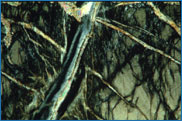An important characteristic of serpentinization is that the hydration reactions in the mantle rocks are exothermic – that is, they consume water and produce a significant amount of heat during the transformation of olivine to serpentine and magnetite. The amount of heat produced is directly proportional to the amount of water that is taken up to form the mineral serpentine. In fact, serpentinization consumes an average of about 300 kilograms (approximately 300 liters or 79 US gallons) of water per cubic meter of rock that is altered. At the same time, this process produces about 660,000,000 joules of heat per cubic meter of rock. In simple terms, the amount of energy produced by serpentinization of one cubic meter of rock (about 35 cubic feet) is enough to run a 100 watt light bulb for about 76 days!
 |
The geological significance of this heat effect is that serpentinization processes are capable of raising the rock temperature by about 260°C (550°F), if one ignores processes that lead to heat transport and cooling of the rock. It is this heat source that appears to be driving the Lost City hydrothermal system. This is in strong contrast to other known hydrothermal systems along the mid-ocean ridges, which are driven by magmatic heat and are characterized by high temperature, metal-rich fluids that ultimately create spectacular “Black Smoker” sulfide structures. Some of the questions that we will try to answer with our studies of the Lost City system are: How fast has serpentinization taken place at the Atlantis Massif? What are the hydrothermal temperatures today and how hot has this system been in the past? How long can serpentinization sustain hydrothermal activity in the future?